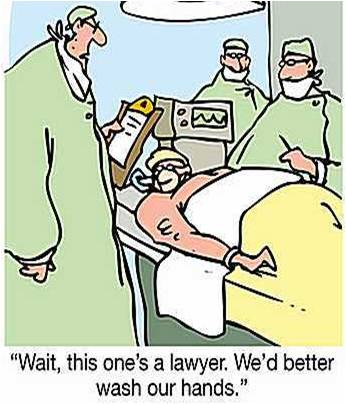Lawsuits – the driving force for change.
I’m in the hospital right now – not as a patient (this time) but visiting a family member who is a patient. It’s a good hospital – better than most. It’s in my home town and I have been here many, many times for various reasons and I’ve witnessed everything except an actual operation in progress.
Because I’ve seen so much, I’ve been able to notice some significant changes to procedures over the years – changes for the better. For one thing, when blood or what they call “blood products” (plasma, etc.) are to be given to a patient, there are at least two people on the task. They scan the bar codes on the patient’s wrist band (another innovation from several years back) and the bar codes on the blood. They don’t just rely on technology, though. They read the full name and other identification information about the patient and the material aloud. They verify the blood type at least twice and maybe three times. All this to assure that the wrong thing doesn’t go into a patient.
Another interesting procedural innovation is in the way that the head doctor (attending physician) of a department conducts what are called “rounds”. This is where the doctor gathers and verifies information on the patient from all of a patients nurses, therapists, etc. All the information has already been entered on the computer system and the doctor has a linked laptop computer right in front of him. But everyone is required to verify each piece of relevant information from his or her own notes. Then, the doctor gives any visitors who are present at the time a breakdown in understandable language of the patient’s condition, prognosis, and several details.
Everywhere I look, as I walk around and watch the hospital at work, I see caution, verification, and various other methods of, essentially, mistake prevention. So why has this system evolved so well? Well, one important reason is malpractice lawsuits.
A hospital could save a significant amount of money by having only one person administer blood products, but even infrequent mistakes can cost MUCH more in lawsuits and legal fees. So, mistake-preventing procedures pay for themselves, perhaps many times over. The result (a positive externality) is that patients enjoy improved safety and improved medical care. So, lawsuits have driven these changes.
There are two alternatives to the present, lawsuit-based system when it comes to the relationship between individuals and corporations (including hospitals): much stronger government regulation to protect patients (and consumers of various types) or simply trusting market mechanisms. The former might be viable if strict regulations had sharp teeth – large fines and even criminal charges in some cases (more than now). To work, this would require enforcement on many levels – again, more enforcement than we have now. We would have to agree, as a society, that good treatment of individuals outweighs profit maximization.
On the other hand, letting corporations essentially choose how relationships with individuals work would mean that society had chosen to believe that profit maximization would drive these relationships to an “optimal” form. The idea is essentially that poor quality of services delivered will cause the business to suffer because the flow of customers will stop.
One problem with this is that the negative publicity that might come from news of an accidental and unnecessary fatality can be overcome by an active public relations (PR) campaign – TV commercials, magazine and newspaper ads, etc. All that need be done is to feature some trustworthy-looking person telling a story (fictional) about what a great hospital this one is. And so, the principle that the market will punish poor quality often fails.
Essentially, the market drives improvements incrementally and usually only within a short time horizon – within which changes in profits are quickly apparent. Without lawsuits or fines shifting the cost equation, many improvements to safety practices would either never happen, or would happen much more slowly.
Am I actually praising lawsuits? No, but lawsuits are yet another necessary evil in our world. It’s the most effective and efficient way we have to coerce painful, otherwise bottom-line worsening changes that are in the best interest of patients and consumers. Lawsuits are a way of shifting the balance back toward human well-being.
-Tom Rossi
___________________________________________________________________________
Tom Rossi is a commentator on politics and social issues. He is a Ph.D. student in International Sustainable Development, concentrating in natural resource and economic policy. Tom greatly enjoys a hearty debate, especially over a hearty pint of Guinness.
Tom also posts on thrustblog.blogspot.com
___________________________________________________________________________


